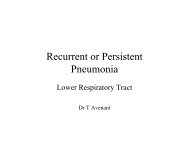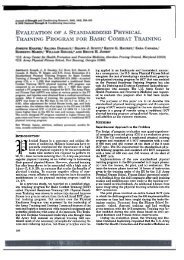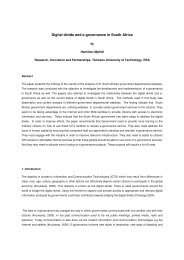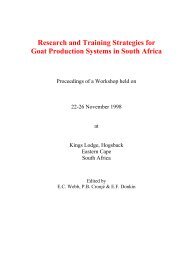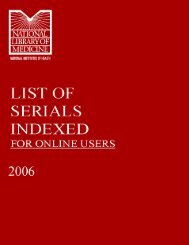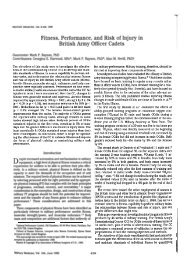NUTRITION INFANCY AND CHILDREN - University of Pretoria
NUTRITION INFANCY AND CHILDREN - University of Pretoria
NUTRITION INFANCY AND CHILDREN - University of Pretoria
You also want an ePaper? Increase the reach of your titles
YUMPU automatically turns print PDFs into web optimized ePapers that Google loves.
<strong>NUTRITION</strong><br />
<strong>INFANCY</strong><br />
<strong>AND</strong><br />
<strong>CHILDREN</strong><br />
Dr Sieglinde Hanekom<br />
MB,ChB(Pret), MMed(Fam Med)(Pret)<br />
2002
<strong>INFANCY</strong> <strong>AND</strong> <strong>CHILDREN</strong><br />
2<br />
_____________________________________________________________________________<br />
LEARNING OBJECTIVES<br />
1. BREASTFEEDING<br />
1. Breastfeeding – instigating and maintaining breastfeeding.<br />
2. Lactating mother – practical guidelines for the lactating woman,<br />
identifying and treating problems and complications.<br />
3. Formula feed.<br />
4. Adding fluids and milk to the diet.<br />
5. Adding solids to the diet.<br />
6. Weaning.<br />
7. Allergies and food intolerance.<br />
8. Identification <strong>of</strong> toxins and the diagnosis and treatment <strong>of</strong><br />
poisoning.<br />
• Breastfeeding is always the preferred method <strong>of</strong> feeding an infant (definitely during the first<br />
6 months <strong>of</strong> life) and even the young child. Breast milk <strong>of</strong>fers many advantages to<br />
developing infants i.e. lower rates <strong>of</strong> gastrointestinal disease, anaemia, respiratory ailments<br />
and otitis media. In addition, breastfeeding provides a unique opportunity for bonding<br />
between infant and mother.<br />
• The position <strong>of</strong> the mother is very important in breastfeeding. She needs to sit in a big<br />
comfortable chair and must listen to what the baby is doing - he needs to suck and swallow<br />
(not suck and suck without actually drinking).<br />
• All the milk is nutritious, although there is less fat and carbohydrates in the first 20 ml <strong>of</strong><br />
breast milk.<br />
• The baby must drink from both breasts at every feed.<br />
• One feed takes about 20 minutes (5-10 minutes on each breast).<br />
• Hold both hands under the baby's arms and hold him upright to expel winds.<br />
• It is easy and practical to demand-feed (feeding when asked for).<br />
• Iron deficiency can develop in a breast fed baby - do a blood count at 6-9 months to<br />
exclude this, especially if he does get recurrent infections.<br />
Frequency <strong>of</strong> feeds:<br />
♦ 2,3-2,8 kg: usually 2½ hourly feeds (must wake the baby after 3 hours to feed, because <strong>of</strong><br />
possible side effects e.g. hypoglycaemia, vomiting, choking).<br />
♦ >3 kg: 3-4 hourly feeds, but if the baby is awake after 2½ hours, he can be fed. Wake him<br />
after 4 hours for a feed until the age <strong>of</strong> 14 days.<br />
Problems in breastfeeding:<br />
2. Low birth weight: These babies tire quickly and the sucking reflex is <strong>of</strong>ten not well<br />
developed. Give breast milk in a bottle until he has gained enough weight to be able to suck<br />
better, but always put the baby on the breast before giving the bottle.<br />
Copyright © <strong>University</strong> <strong>of</strong> <strong>Pretoria</strong>
<strong>INFANCY</strong> <strong>AND</strong> <strong>CHILDREN</strong><br />
3<br />
_____________________________________________________________________________<br />
3. High palate: The nipple does not fit into the mouth (palate) <strong>of</strong> the baby. Use a bottle with<br />
expressed breast milk or formula feed.<br />
4. Weight gain: Weigh the baby before and after a feeding session. He needs to gain 100 g<br />
per session = 100 ml.<br />
5. Baby does not want to drink: Here it is important to look for a secondary cause which<br />
may include:<br />
� Urinary tract infection.<br />
� Bilateral reflux.<br />
� Heartburn.<br />
� Emotional deprivation.<br />
� Congenital or other acquired disease.<br />
6. Too much weight gain:<br />
� Weighing with clothes on or with a wet nappy.<br />
� Overfeeding.<br />
QUESTIONS ANSWERS<br />
Why does a low birth-weight baby need<br />
more frequent feeding?<br />
Give 5 possible reasons for an infant who<br />
refuses to drink.<br />
Give 1 common complication <strong>of</strong> breastfeeding<br />
exclusively without<br />
supplementation.<br />
2. LACTATING MOTHER<br />
Hypoglycaemia.<br />
Vomiting.<br />
Choking.<br />
Copyright © <strong>University</strong> <strong>of</strong> <strong>Pretoria</strong><br />
Urinary tract infection.<br />
Bilateral reflux.<br />
Heartburn.<br />
Emotional deprivation.<br />
Congenital or other acquired disease.<br />
Iron deficiency.<br />
It is possible to enjoy breastfeeding a baby, but a woman needs to be positively influenced and<br />
motivated by all medical staff involved in her pregnancy.<br />
Problems may arise during the first week and a poorly motivated mother may not be able to<br />
overcome these obstacles on her own.<br />
Wear a good quality brassière with good support.<br />
It is important to check for iron and folic acid deficiency in the lactating mother - she has to use an<br />
iron and folic acid combination supplement while lactating.<br />
Problems during lactation:<br />
� After birth pains: Explain to the new mother that it is caused by the release <strong>of</strong> oxitocin in the<br />
blood and contraction <strong>of</strong> the uterus. They always accept it if it is stressed that this would lead to<br />
a normal sized uterus quicker and a normal figure as well.<br />
� Not enough milk: It depends on the medical team – motivate the mother to persevere. After 6<br />
weeks postpartum the milk production stabilizes (the mother relaxes and is used to a new<br />
routine). It needs to be stressed that if she can continue for 6-8 weeks, the rest will be very<br />
easy and always beneficial to the baby.
<strong>INFANCY</strong> <strong>AND</strong> <strong>CHILDREN</strong><br />
4<br />
_____________________________________________________________________________<br />
Treatment:<br />
� Rest a lot during the day.<br />
� Drink 6-8 glasses <strong>of</strong> water per day.<br />
� The baby must stimulate the breast to increase milk production.<br />
� Diet (dairy products).<br />
� Eglonyl (Sulpiride) (a last resort). Also helps relieve postpartum depression. Use 1<br />
tablet 1-3x/day.<br />
� Barley Green (a natural product with calcium & magnesium and a high concentration <strong>of</strong><br />
chlorophil).<br />
� Milk stout (Vit B) - can cause weight gain.<br />
� Inverted nipples: May be difficult to breast-feed, a Woolwich nipple shield worn during<br />
pregnancy may help, but it is uncomfortable. Some babies can be breastfed with the shield if<br />
his sucking reflex is strong, but it is sometimes necessary to terminate breastfeeding. The<br />
mother may give the baby expressed breast milk.<br />
� Prosthesis: The mother will usually have less milk, but it may be possible to breastfeed with<br />
extra formula feed. The woman needs to be motivated and determined to succeed.<br />
� Engorged mammae: Use demand feeding with 2-4 hours in between feeds. It usually<br />
disappears after 6 days. Do not handle the breasts too much.<br />
� Blocked duct: Place a warm cloth on the lump, gently massage the lump and <strong>of</strong>fer the<br />
affected breast first. Continue breastfeed to empty the breast.<br />
� Mastitis: This is a tender red area on the breast with a low grade fever, and is not an abscess<br />
per se. The cause is usually Staphylcoccus aureus from the baby's mouth and will thus not<br />
harm the baby. It is very important to keep the breast as empty as possible. Have the baby on<br />
the first breast until it is empty and then on the second breast. He will probably not empty the<br />
second breast completely and the mother would need to express that breast at the end <strong>of</strong> a<br />
feed.<br />
Treatment is thus:<br />
� Keep the breasts empty.<br />
� Use heat or even ice on the affected part.<br />
� Paracetamol for the pain and inflammation.<br />
� Reassure the mother that this is just a temporary setback.<br />
� Inform the mother that the process <strong>of</strong>ten repeats itself, but that it is not harmful to<br />
her or the baby's health.<br />
� Abscess: If mastitis is not treated properly, an abscess may develop. This gives a very tender<br />
and possibly fluctuating mass in the breast with severe constitutional symptoms. Treatment<br />
consists <strong>of</strong> antibiotics and surgical drainage. It is necessary to express milk from the affected<br />
breast and to discard it. The baby needs to be taken <strong>of</strong>f the affected breast for a few days, but<br />
can continue drinking from the other breast. It may be difficult to reinstate breastfeeding, but<br />
not impossible. The mother needs to persevere and can take paracetamol for the first few<br />
feeds to relieve the pain.<br />
� Candida on the nipple: A baby with oral Candidiasis can infect the mother's nipples. It<br />
consists <strong>of</strong> very painful blisters. Treat with an antifungal ointment (e.g. Mycostatin or Canesten)<br />
but do not take the baby <strong>of</strong>f the breast. Clean the breast before feeds with breast milk / sterile<br />
water / saline and bite on the teeth for a few minutes. Rather change to the second breast<br />
sooner or use a painkiller once or twice.<br />
Copyright © <strong>University</strong> <strong>of</strong> <strong>Pretoria</strong>
<strong>INFANCY</strong> <strong>AND</strong> <strong>CHILDREN</strong><br />
5<br />
_____________________________________________________________________________<br />
� Sore nipples: Usually because <strong>of</strong> keeping the baby on the breast for too long during the first 1-<br />
3 days (not yet enough milk).<br />
o Day 1: Only 1-3 minute on each breast.<br />
o Day 2: 3-5 minutes on each breast.<br />
o Day 3: 5-7 minutes on each breast.<br />
o Day 4: 7-10 minutes on each breast.<br />
Breast feed more <strong>of</strong>ten - it stimulates milk production.<br />
Direct sunlight 3pm will be effective.<br />
A nipple cream <strong>of</strong> zinc and Friar's balsam can also be effective.<br />
Because <strong>of</strong> the high incidence <strong>of</strong> psychiatric illness during the 3 months after delivery, it raises the<br />
possibility that psychotropic medication will be administered. Issues to address during analysis <strong>of</strong><br />
the risks and benefits <strong>of</strong> psychotropic use during breast-feeding include documented benefits <strong>of</strong><br />
breast-feeding, potential adverse impact <strong>of</strong> untreated maternal mental illness on infant attachment<br />
and cognitive and behavioral development, and the effects <strong>of</strong> untreated mental illness on the<br />
mother. Factors affecting medication concentration in breast milk are pH, protein lipid content<br />
(these vary throughout the postpartum period and at different times during a single feeding). Other<br />
major factors also include lactose, serum albumin, lysozyme, approximately 30 enzymes, prolactin<br />
and minerals such as calcium and phosphates.<br />
The extent to which an infant is exposed to medication is affected by<br />
� the rate <strong>of</strong> absorption into maternal circulation<br />
� diffusion from maternal circulation to breast milk<br />
� absorption <strong>of</strong> the agent by the infant.<br />
Taking medication immediately after breastfeeding minimizes the amount present in milk and<br />
maximizes clearance before the next feeding.<br />
Premature and full-term infants have a diminished capacity to metabolize medications for at least<br />
the first 2 weeks <strong>of</strong> life. The newborn kidney is also functionally immature (the glomerular filtration<br />
rate and tubular secretion are 20 to 40% <strong>of</strong> the adult kidney). For full-term infants, adult glomerular<br />
filtration rates are achieved between 2 and 5 months <strong>of</strong> life. The newborn blood-brain barrier is<br />
also immature (thus lipid-soluble agents can be 10-30 times more concentrated in the CSF than in<br />
serum).<br />
Specific drugs:<br />
� Tricyclic antidepressants: Safe when lactating.<br />
� Selective serotonin reuptake inhibitors: Safe in lactation, except for unconfirmed reports <strong>of</strong><br />
Fluoxetine causing colic and transient seizure-like activity at 3 weeks <strong>of</strong> age and<br />
unresponsiveness at 4 months (all events only reported by the mother and not witnessed by<br />
any medical personnel).<br />
� Antibiotics: Only 2 is safe in lactation, e.g. Penicillin and Erythromycin.<br />
� Painkillers: Only Paracetamol can be taken while lactating.<br />
� It is impossible to know every drug, but if in doubt, use a good reputable handbook for<br />
information on the use <strong>of</strong> the specific drug in lactation.<br />
� Generally speaking, it is safer to avoid all medications if possible while lactating.<br />
Copyright © <strong>University</strong> <strong>of</strong> <strong>Pretoria</strong>
<strong>INFANCY</strong> <strong>AND</strong> <strong>CHILDREN</strong><br />
6<br />
_____________________________________________________________________________<br />
QUESTIONS ANSWERS<br />
Give a differential diagnosis <strong>of</strong> a tender<br />
lump(s) in the breast(s) during lactation.<br />
What advice can be given to a mother who<br />
says: ‘I have not got enough milk to feed<br />
my baby, but I want to breastfeed’?<br />
Is it possible for a woman with breast<br />
prostheses to breastfeed? Motivate your<br />
answer.<br />
The extent to which an infant is exposed to<br />
medication is affected by:<br />
3. BOTTLE-FEEDING<br />
Blocked duct<br />
Mastitis<br />
Abscess<br />
Rest a lot.<br />
Drink 6-8 glasses <strong>of</strong> water per day.<br />
The baby must stimulate the breast to<br />
increase the milk production.<br />
Diet (dairy products).<br />
Eglonyl (Sulpiride)<br />
Barley Green<br />
Milk stout (Vit B)<br />
Yes.<br />
Less milk<br />
Possible to breastfeed with extra formula<br />
feed.<br />
Motivated<br />
Determined to succeed.<br />
The rate <strong>of</strong> absorption into maternal<br />
circulation<br />
Diffusion from maternal circulation to<br />
breast milk<br />
Absorption <strong>of</strong> the agent by the infant.<br />
Breast milk is the best for babies, but if mothers cannot or do not want to breastfeed, it is important<br />
that they use an infant formula that closely resembles breast milk. However, not every baby has<br />
exactly the same needs. A range <strong>of</strong> infant formulas are available which satisfies 99% <strong>of</strong> the<br />
nutritional requirements <strong>of</strong> babies at different stages <strong>of</strong> development.<br />
Available infant formulae:<br />
• S26, NAN, SMA, Similac PM 60/40, Similac with iron (for the normal non-allergic infant).<br />
• Infasoy or Lactogen 1 or 2 for the infant with cow’s milk intolerance symptoms.<br />
• Infasoy 2 for milk-free nutrition for infants 6 months and older.<br />
• Infagro – a follow-on formula for the weaning child <strong>of</strong> 6 months and older.<br />
• Progress – milk for children from 1 year onwards.<br />
• Cow's milk - for the infant from 1 year onwards.<br />
Copyright © <strong>University</strong> <strong>of</strong> <strong>Pretoria</strong>
<strong>INFANCY</strong> <strong>AND</strong> <strong>CHILDREN</strong><br />
7<br />
_____________________________________________________________________________<br />
BIRTH S26<br />
NAN<br />
SMA<br />
4 months S26<br />
NAN<br />
SMA<br />
6<br />
months<br />
12<br />
months<br />
18<br />
months<br />
2<br />
years<br />
3<br />
years<br />
4<br />
years<br />
Similac<br />
S26<br />
NAN<br />
SMA<br />
Similac<br />
QUESTIONS ANSWERS<br />
Which 1 <strong>of</strong> the following is true <strong>of</strong> infant<br />
formula in comparison to breast milk?<br />
Which 1 <strong>of</strong> the following is unlikely to<br />
decrease the rate <strong>of</strong> transmission <strong>of</strong> the<br />
human deficiency virus?<br />
4. FLUIDS & MILK:<br />
Infasoy<br />
Lactogen 1<br />
Infasoy<br />
Lactogen 2<br />
Infagro Infasoy<br />
Lactogen 2<br />
Infagro Infasoy<br />
Lactogen 2<br />
Infagro Infasoy<br />
Lactogen 2<br />
Infasoy<br />
Lactogen 2<br />
Infasoy<br />
Lactogen 2<br />
Infasoy<br />
Lactogen 2<br />
Infasoy 2<br />
It has less calcium.<br />
It has less phosphorus.<br />
It has more iron.<br />
It has less protein.<br />
It has taurine.<br />
Banking <strong>of</strong> human milk.<br />
Use <strong>of</strong> antiretrovirals.<br />
Early weaning.<br />
Use <strong>of</strong> vitamin E supplements.<br />
Exclusive formula feeding.<br />
Infants 0-4 months:<br />
� Only give breast milk or formula milk.<br />
� These babies do not need extra water if breastfed, but need to be breastfed on<br />
demand.<br />
� If they are bottle-fed, bottle feeds should be given at least every 4 hours - they can be<br />
given extra cooled boiled water on very hot days.<br />
� Formula feed: 1 scoop <strong>of</strong> milk per 25 ml <strong>of</strong> boiled cooled water.<br />
� The average intake from 1 week <strong>of</strong> age until the infant is weaned is about 150<br />
ml/kg/day.<br />
� No cow's milk should be given before the age <strong>of</strong> 1 year (the renal load is too high and it<br />
leads to iron-deficiency anaemia).<br />
Copyright © <strong>University</strong> <strong>of</strong> <strong>Pretoria</strong><br />
Infasoy 2 Progress Cow's<br />
milk<br />
Infasoy 2 Progress Cow's<br />
milk<br />
Infasoy 2 Progress Cow's<br />
milk<br />
Infasoy 2 Progress Cow's<br />
milk<br />
Infasoy 2 Progress Cow's<br />
milk
<strong>INFANCY</strong> <strong>AND</strong> <strong>CHILDREN</strong><br />
8<br />
_____________________________________________________________________________<br />
4-6 months:<br />
� Milk is still the most important source <strong>of</strong> food.<br />
� Continue breastfeeding.<br />
� Continue bottle-feeding every 4 hours.<br />
� If the baby does not take in enough solid food and is still on formula feed, the follow-up<br />
formula must be given, such as Infagro, Lactogen 2 or Similac with iron.<br />
� Extra cooled boiled water can be given twice a day.<br />
6-9-months:<br />
� Breastfeed on demand.<br />
� Formula feeds can still be used.<br />
� Give cooled boiled water twice a day.<br />
� Fruit juice is discussed in 5 (adding solids).<br />
9-12 months:<br />
� Breastfeed on demand.<br />
� Formula feeds can still be used.<br />
� Give cooled boiled water twice a day.<br />
1 year & older:<br />
� Cow's milk can be given now.<br />
� Only full cream milk must be used.<br />
� Fresh or real dairy powder milk e.g. Nespray can be used.<br />
� Children that are not breastfed anymore must drink 2 cups <strong>of</strong> milk per day (500ml).<br />
� Tap water must be given twice or three times a day.<br />
QUESTIONS ANSWERS<br />
No cow's milk should be given before the<br />
age <strong>of</strong> 1 year. Why not?<br />
True or False<br />
1. Breastfed infants 0-4 months need<br />
extra water.<br />
2. Infants on formula feed <strong>of</strong> 4-6<br />
months old need extra tap water.<br />
3. Infants 6-9 months <strong>of</strong> age must<br />
have cooled boiled water on hot<br />
days.<br />
5. ADDING SOLIDS<br />
Renal load is too high<br />
Iron-deficiency anaemia.<br />
1. False<br />
2. False<br />
3. True<br />
Solids are usually added when the birth weight has been doubled.<br />
4-6 months:<br />
1. Energy food (starch):<br />
a. Iron enriched grains, for example rice porridge, Nestum, Cerelac, Nestle Infant<br />
cereal with soya or mealie-, oats (sifted) or maltabella porridge, and mashed<br />
potatoes should be given as first food introduced for 2-3 weeks.<br />
b. Start with 1 teaspoon 3 times per day.<br />
c. Increase it to 2 teaspoons 3 times per day.<br />
d. Continue increasing intake to 3 teaspoons 3 times per day.<br />
e. Increase intake further as the baby's needs increase.<br />
Copyright © <strong>University</strong> <strong>of</strong> <strong>Pretoria</strong>
<strong>INFANCY</strong> <strong>AND</strong> <strong>CHILDREN</strong><br />
9<br />
_____________________________________________________________________________<br />
2. Protective food (vitamins & minerals):<br />
After 3 weeks:<br />
1. Continue giving porridge.<br />
2. Start with the introduction <strong>of</strong> vegetables and fruit. The order is not important,<br />
however some babies may not want to eat veggies once they have become<br />
used to the sweet taste <strong>of</strong> fruit. Therefore it is recommended that one starts with<br />
the introduction <strong>of</strong> veggies first.<br />
3. Give 1-2 teaspoons at a time for at least 3 days before introducing the next type<br />
<strong>of</strong> food.<br />
4. Watch out for any allergic reaction such as a rash, itchy eyes, runny nose,<br />
scratching <strong>of</strong> ears or skin or lung problems before introducing the next type <strong>of</strong><br />
food.<br />
5. Give a ¼ cup <strong>of</strong> juice or 1-2 teaspoons <strong>of</strong> a fruit at a time.<br />
6. Pure fruit juice may not replace milk in the diet.<br />
7. Give one type <strong>of</strong> fruit for at least 3 days and watch for any allergic reaction.<br />
6-9 months:<br />
� Energy and Protective foods:<br />
1. Continue to give grains and a variety <strong>of</strong> veggies and fruit as the baby is used to.<br />
� Body building food (protein)<br />
1. This is food that provides mainly protein, i.e. egg yolk, meat or chicken.<br />
2. Initially give only egg yolk. It can be added to hot porridge slightly cooked. Egg<br />
white should only be added to the diet from age 9 months to 1 year.<br />
3. Cook meat or chicken until s<strong>of</strong>t. It can be cut finely, minced or pulverized in a<br />
food processor.<br />
4. Peanut butter, dry beans or soya can also be given if no other source <strong>of</strong> protein<br />
is available. Otherwise it should only be given from the age <strong>of</strong> 9 months to 1<br />
year.<br />
5. The sauce from the meat or chicken is not sufficient for the baby.<br />
9-12 months:<br />
� Energy and Protective foods:<br />
Continue to give grains and a variety <strong>of</strong> vegetables and fruit as the baby is accustomed to.<br />
Give it in a coarse form e.g. pieces instead <strong>of</strong> puree.<br />
� Body building food:<br />
1. If the baby already has teeth, meat can also be cut into small pieces.<br />
2. The whole egg (white & yolk) can be given now.<br />
3. Fish can be included in the diet.<br />
4. Peanut butter, dry beans & soya mince such as Toppers, Imana & Oxo can also<br />
be given if it has not been introduced yet.<br />
1 year & older:<br />
� Protective foods:<br />
1. Try to give a variety <strong>of</strong> fruit & veggies.<br />
2. Must eat at least 4-6 portions <strong>of</strong> fruit & veggies per day (1 portion = ½ cup <strong>of</strong><br />
veggies / 1 fruit).<br />
3. The child must eat at least 1 yellow, 1 green & 1 raw fruit or vegetable per day.<br />
� Energy food:<br />
1. Don’t give maize porridge only.<br />
2. Also give oats, maltabella, rice, sweet potato, mealierice, samp & brown bread.<br />
3. Small amounts <strong>of</strong> oil or margarine can be added to food or margarine can be<br />
spread thinly on bread.<br />
Copyright © <strong>University</strong> <strong>of</strong> <strong>Pretoria</strong>
<strong>INFANCY</strong> <strong>AND</strong> <strong>CHILDREN</strong><br />
10<br />
_____________________________________________________________________________<br />
4. The child must eat 4-6 portions <strong>of</strong> starch per day (1 portion = 1 slice <strong>of</strong> bread / ½<br />
cup <strong>of</strong> another starch).<br />
5. 6 Teaspoonfuls <strong>of</strong> fat can be used per day.<br />
� Body building food:<br />
1. Any protein food can be given now, e.g. meat, fish, chicken, dry beans, lentils,<br />
soya, eggs, peanut butter & other nuts.<br />
2. If meat is too expensive, choose cheaper sources <strong>of</strong> protein e.g. eggs, peanut<br />
butter, soya & dry beans.<br />
3. Give 2 portions per day (1 portion = 1 tablespoon per year <strong>of</strong> age).<br />
GENERAL GUIDELINES:<br />
1. Don't force the baby to eat something if he refuses it. Try specific foods again at a later<br />
stage. The first food must have a smooth texture.<br />
2. Do not give infants c<strong>of</strong>fee or tea. Rooibos tea can be given.<br />
3. Cooldrinks, sweets & chips must be avoided, especially if it is used at the expense <strong>of</strong><br />
healthy food.<br />
4. Test the temperature <strong>of</strong> the food; it must not burn your wrist.<br />
5. Feed solid foods in the upright position with a spoon.<br />
6. Prepared products (e.g. Purity) can be bought, but is expensive.<br />
7. It is not necessary to add salt to baby food.<br />
8. Butter can be added in small quantities.<br />
9. Honey may not be given before the age <strong>of</strong> 1 year.<br />
QUESTIONS ANSWERS<br />
Which food provides energy to the<br />
body?<br />
Starch<br />
Which food builds the body? Protein<br />
Discuss the introduction <strong>of</strong> solids to a<br />
mother with her first baby.<br />
What is the cheapest and best<br />
alternative to meat that can be given<br />
from 6 months?<br />
Energy foods, cereals, rice porridge,<br />
mashed potatoes –2-3 weeks<br />
Vegetables, fruit – 1 at a time.<br />
Egg yolk.<br />
6. WEANING<br />
� Do not stop breastfeeding suddenly, but breastfeed every second feed for 24 hours,<br />
then every third feed for 24 hours, then every fourth feed for 24 hours.<br />
� Even if a mother has to go back to work, she can still continue breastfeeding for 1 to 2<br />
years. Supply the daycare centre with expressed breast milk or give formula feed during<br />
the day, but breastfeed early in the morning and during the night.<br />
� Bromocriptine (Parlodel) can also be used if the lactation needs to be stopped for a<br />
specific medical reason. Dosage: ½ tablet (1,25 mg) bd x14 days.<br />
� It is important that the baby must be able to eat solids before he is weaned.<br />
� The baby must also be given extra water at least twice a day to avoid dehydration.<br />
Copyright © <strong>University</strong> <strong>of</strong> <strong>Pretoria</strong>
<strong>INFANCY</strong> <strong>AND</strong> <strong>CHILDREN</strong><br />
11<br />
_____________________________________________________________________________<br />
QUESTIONS ANSWERS<br />
Is it possible for a working mother to<br />
continue breastfeeding her baby? Please<br />
motivate your answer.<br />
A young mother needs to wean her 6<br />
month old baby. Discuss 2 ways to stop<br />
lactation.<br />
7. ALLERGIES <strong>AND</strong> FOOD INTOLERANCE<br />
Copyright © <strong>University</strong> <strong>of</strong> <strong>Pretoria</strong><br />
Yes.<br />
Expressed milk to the daycare center or<br />
formula feed during the day.<br />
Breastfeed during the night.<br />
Decrease breastfeeding over 3-4 days.<br />
Parlodel (Bromocriptine) 1.25 mg bd x14<br />
days.<br />
Allergy is the name given to a wide spectrum <strong>of</strong> diseases <strong>of</strong> clinical conditions, but the<br />
common feature is that they all are caused by the over-production in the patient's immune<br />
system <strong>of</strong> an antibody called IgE. The clinical conditions are most commonly:<br />
� Asthma.<br />
� Eczema.<br />
� Urticaria.<br />
� Rhinitis.<br />
� Hay fever.<br />
� Adverse reactions to food.<br />
� Conjunctivitis.<br />
There are over 400 environmental agents that have been proven to cause allergies.<br />
Allergens which commonly cause allergic symptoms include house dust mites, cats' and<br />
dogs' dander, tree pollens, weed pollens, mould spores, bee venoms, antibiotics (e.g.<br />
penicillins, sulphonamides) and many others.<br />
When a new type <strong>of</strong> food is introduced onto the infant's diet, allergic reactions can develop.<br />
Thus it is important to introduce 1 new foodstuff at a time.<br />
Symptoms <strong>of</strong> allergic reactions:<br />
� Rash.<br />
� Stuffy nose.<br />
� Recurrent otitis media.<br />
� Recurrent lung infections.<br />
� Inadequate weight gain.<br />
� Crying incessantly.<br />
� Sleeping problems.<br />
� Infantile colic.<br />
� Cramps.<br />
� Nausea and vomiting<br />
� Diarrhoea.<br />
� Larynx oedema.<br />
� Urticaria.<br />
� Atopic dermatitis.<br />
As house dust (and thus the house dust mite) is a major cause <strong>of</strong> allergic reactions, it is<br />
important to know how to avoid it. Here are some hints:<br />
� Wash bedding at 60 o C to destroy mites.<br />
� Vacuum the whole house twice a week, vacuum early in the morning and open all the<br />
windows.<br />
� Avoid vacuuming, cleaning or dusting with an asthma sufferer in the room.
<strong>INFANCY</strong> <strong>AND</strong> <strong>CHILDREN</strong><br />
12<br />
_____________________________________________________________________________<br />
� Purchase a vacuum cleaner with an efficient filter, otherwise the allergens may be<br />
dispersed in the house.<br />
� Turn the mattress and vacuum monthly. Expose to fresh air and sunlight whenever<br />
possible.<br />
� Keep s<strong>of</strong>t toys to a minimum and store in a cupboard. Place them in the freezer for 6<br />
hours a week. After freezing, vacuum them to remove the dead mites. Wash them<br />
monthly (60 o C).<br />
� Keep window doors open whenever possible.<br />
� Furry pets should stay outside and <strong>of</strong>f the furniture. Keep them and their sleeping areas<br />
clean.<br />
� Avoid padded headboards and cot bumpers for babies.<br />
� When cooking, use a ventilated extractor hood or an extractor fan or keep the doors<br />
open.<br />
� Always damp dust.<br />
The term food intolerance is used when the history and/or the provocation tests clearly prove a<br />
food is the cause <strong>of</strong> the symptoms, but there is no evidence that the defense (immune) system is<br />
involved. It can be caused by various chemicals present in the food that themselves directly cause<br />
an effect on the body.<br />
Here we would classify the intolerance to food additives, such as:<br />
� Tartrazine and other azo dyes (food colourants).<br />
� Aspartame (food flavourings).<br />
� Benzoates and sulphates (food preservatives).<br />
� Food anti-oxidants.<br />
� Intolerance to gluten (Coeliac disease). Symptoms include: weight loss, failure to thrive,<br />
anaemia.<br />
Food substances (e.g. egg, milk, peanuts, certain fruits, etc) can also cause allergic reactions.<br />
Treament in all <strong>of</strong> the above would be to avoid the allergen as far as possible. It is important<br />
though not to stop the intake <strong>of</strong> essential foodstuffs without supplementing the diet with vitamins<br />
and minerals, e.g. if dairy products are the <strong>of</strong>fending allergens, the diet must be supplemented with<br />
calcium and iron.<br />
Copyright © <strong>University</strong> <strong>of</strong> <strong>Pretoria</strong>
<strong>INFANCY</strong> <strong>AND</strong> <strong>CHILDREN</strong><br />
13<br />
_____________________________________________________________________________<br />
QUESTIONS ANSWERS<br />
Discuss ways to avoid the effects<br />
<strong>of</strong> the house dust mite in allergic<br />
children.<br />
Acute attacks <strong>of</strong> asthma in children:<br />
(True / False)<br />
What is the difference between<br />
allergy and food intolerance.<br />
8. TOXINS <strong>AND</strong> POISONING<br />
-Wash bedding at 60 o C to destroy mites.<br />
-Vacuum the whole house twice a week, vacuum early in<br />
the morning and open all the windows.<br />
-Avoid vacuuming, cleaning or dusting with an asthma<br />
sufferer in the room.<br />
-Purchase a vacuum cleaner with an efficient filter,<br />
otherwise the allergens may be dispersed in the house.<br />
-Turn the mattress and vacuum monthly. Expose to fresh air<br />
and sunlight whenever possible.<br />
-Keep s<strong>of</strong>t toys to a minimum and store in a cupboard.<br />
Place them in the freezer for 6 hours a week. After freezing,<br />
vacuum them to remove the dead mites. Wash them<br />
monthly (60 o C).<br />
-Keep window doors open whenever possible.<br />
-Furry pets should stay outside and <strong>of</strong>f the furniture. Keep<br />
them and their sleeping areas clean.<br />
-Avoid padded headboards and cot bumpers for babies.<br />
-When cooking, use a ventilated extractor hood or an<br />
extractor fan or keep the doors open.<br />
-Always damp dust.<br />
The administration <strong>of</strong> IV aminophylline or theophylline<br />
suppositories is potentially lethal.<br />
(True)<br />
Children are very anxious in acute asthma and a sedative or<br />
tranquilliser will improve the asthma. (False)<br />
In acute attacks active physiotherapy is contra-indicated.<br />
(True)<br />
Antibiotics should be routinely prescribed. (False)<br />
Allergy – overproduction <strong>of</strong> IgE.<br />
Food intolerance – No production <strong>of</strong> IgE, but history and/or<br />
provocation tests prove a food is the cause <strong>of</strong> the allergic<br />
symptoms.<br />
Lead poisoning is fairly common in the18-36 month age group, but can easily be overlooked<br />
or misdiagnosed. The risk is greatest in poor, urban and disadvantaged communities and the<br />
most common sources are paint, dust and soil.<br />
Clinical presentation:<br />
� Microcytic hypochromic anaemia.<br />
� Papiloedema.<br />
� Abdominal pain.<br />
� Cerebral oedema.<br />
� Alopecia.<br />
It is a notifiable disease.<br />
Copyright © <strong>University</strong> <strong>of</strong> <strong>Pretoria</strong>
<strong>INFANCY</strong> <strong>AND</strong> <strong>CHILDREN</strong><br />
14<br />
_____________________________________________________________________________<br />
Paracetamol intoxication is fairly common and can cause irreversible liver damage if not treated<br />
timeously and correct. The diagnosis is usually easy, because <strong>of</strong> the history <strong>of</strong> digestion <strong>of</strong> either<br />
tablets or syrup.<br />
Salicylates are very dangerous. Signs include hyperpyrexia, sweating, tachypnoea, acetone<br />
odour, haematemesis, melaena, metabolic acidosis and hypokalaemia.<br />
Organophosphate poisoning is on the increase especially in the age group 3-8 years. Symptoms<br />
include blurred vision, garlic odour, sweating, excessive salivation, lacrimation, miosis, diarrhoea<br />
and vomiting, hypotension, bradycardia, convulsions, muscle weakness, depressed respiration.<br />
Ethanol poisoning is <strong>of</strong>ten overlooked, but is also common, because <strong>of</strong> the availability <strong>of</strong> the<br />
substance.<br />
Cleaning materials e.g. Jik, Milton, Steri-nappi, Handy Andy can also cause intoxication.<br />
Petrochemical products can cause a life-threatening aspiration pneumonia if aspirated.<br />
Treatment <strong>of</strong> intoxication consists <strong>of</strong>:<br />
� Remove the substance.<br />
� Gastric lavage (not for petrochemical substances).<br />
� Treat respiratory inadequacy.<br />
� Treat circulatory failure.<br />
� Treat shock / hypotension.<br />
� Treat convulsions.<br />
� Treat hypoglycaemia.<br />
� Treat hypothermia.<br />
� Give antidote if available.<br />
QUESTIONS ANSWERS<br />
Which 1 <strong>of</strong> the following is true <strong>of</strong><br />
pollutants?<br />
Discuss the general treatment <strong>of</strong><br />
intoxication.<br />
They are more concentrated in the serum<br />
<strong>of</strong> the mother than in human milk<br />
Their concentration is higher in cow’s milk<br />
than in human milk.<br />
They may cause mass poisoning.<br />
They are rarely present in human milk.<br />
They clearly increase the risk <strong>of</strong> cancer.<br />
Remove the substance.<br />
Gastric lavage (not for petrochemical<br />
substances).<br />
Treat respiratory inadequacy.<br />
Treat circulatory failure.<br />
Treat shock / hypotension.<br />
Treat convulsions.<br />
Treat hypoglycaemia.<br />
Treat hypothermia.<br />
Give antidote if available.<br />
Copyright © <strong>University</strong> <strong>of</strong> <strong>Pretoria</strong>
<strong>INFANCY</strong> <strong>AND</strong> <strong>CHILDREN</strong><br />
15<br />
_____________________________________________________________________________<br />
REFERENCES:<br />
1. Sr ACM Cronje. The woman with the lactating breast. Lecture given to<br />
MMed(Fam Med) students on 21 February 1998.<br />
2. Sr ACM Cronje. Problems with breastfeeding. Lecture given to MMed(Fam<br />
Med) students on 17 August 2000.<br />
3. Pr<strong>of</strong> PC Potter; Allergy diagnosis. <strong>University</strong> <strong>of</strong> Cape Town Medical School.<br />
4. Dr Harris Steinman. Food allergy diagnosis. Allergy Society <strong>of</strong> South Africa.<br />
5. Vincent C Harrison. Handbook <strong>of</strong> Paediatrics. p209-217. Oxford <strong>University</strong><br />
Press. Southern Africa. 1999.<br />
6. Introduction <strong>of</strong> solids. Kalafong Hospital: Human Nutrition.<br />
7. Lteif AN, et al; Breast milk revisited (Concise review for primary-care<br />
physicians). Mayo Clin Proc 1998;73: 760-763.<br />
Copyright © <strong>University</strong> <strong>of</strong> <strong>Pretoria</strong>








